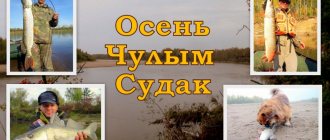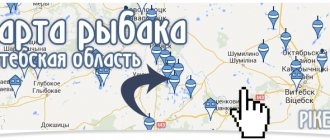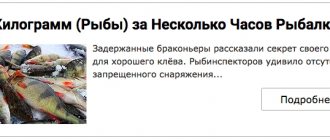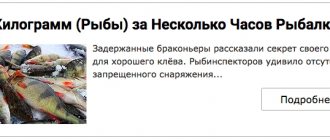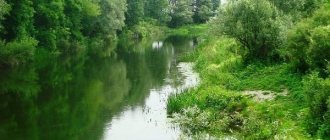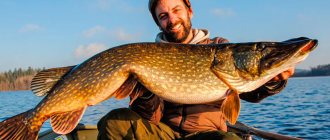The Kursk region is one of the best areas for recreation and fishing with paid ponds and free places for recreation. Here you can find excellent places for relaxing with the whole family, fishing and fishing competitions. The Kursk region is famous for its large number of ponds, small rivers and lakes, which contain a lot of white fish. Below are video materials with fishing reports in different areas of the Kursk region. Review of fishing reports in Kursk, Zheleznogorsk, Lipnik and Krasny Kut, Stepanovka. Introducing the fisherman's forum, which has a section on Kursk fishing and hunting.
Free ponds
Small Pond (Paniki village)
Maly pond is located near the village of Paniki, Kursk region. The road to the village is dirt, access is possible even after rain. Here you can catch crucian carp up to one kilogram, roach and perch. The best gear to use is a spinning rod and a float rod.
Local fishermen say that the fish take well on the following baits:
- Earthworm and dungworm.
- Semolina, semolina with peas.
- Peas and corn.
There are many ponds in the Kursk region where you can fish freely. Almost every village has a pond, and sometimes several.
Paid ponds
Prilepa Pond
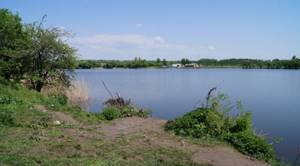
The paid reservoir of Prilepa receives fishermen from all over the region every day. But, unfortunately, there are no big fish here. Most often small fish bite: roach, crucian carp and perch. If you're lucky, you can catch carp (very rare). The best bait to use is maggots, worms, and canned corn. Tackle: float rod, feeder.
Reutets Pond
The pond is located in the Medvedsky district in the village of Reutets. There is a fee for fishing on this pond. Having taken a ticket to Reutets, not a single fisherman will leave here without a good catch. There are plenty of crucian carp, grass carp, carp, carp, as well as small perch and roach here. The bait is the most common: peas, corn, semolina and worm. Tackle: float rod and spinning rod.
Pond Stepanovka
Stepanovka pond is quite large, fishing on it is paid (with vouchers). It is allowed to fish only with a float rod and spinning rod. Near the dam there is a security post that checks the availability of tickets, gear and, at the end, the catch. Recommended bait: peas, corn, semolina, worm. Here you can catch fairly large carp, grass carp, crucian carp, perch, and roach.
The second Kursk Region Fishing Cup was held here.
Pond Trinity
Fishing on the pond in the village of Trinity is paid. The owners of the pond have done a good job of creating the coastal area: the shore is clean, lanterns are lit in the dark, and there are no thickets. The fish you can catch here are:
- crucian carp
- large carp (sometimes even weighing 5 kg)
- grass carp.
The best gear to use is bottom and float fishing rods and spinning rods for perch.
Bait:
- Red dung worm, sometimes earthworm.
- Peas, corn.
- Semolina.
Rivers
The Psel River is an excellent place for fishing and recreation. It is a tributary of the mighty and large Dnieper. Experienced fishermen go to the river to fish for crucian carp, chub, and bream. Other types of fish here are difficult to catch, but quite possible. The best gear to use is bottom fishing rod and spinning rod. Bait: worm and maggot, corn and dough.
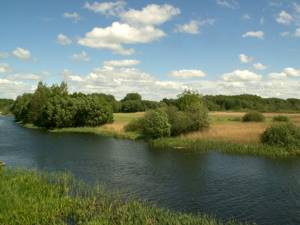
Fishing river Seim
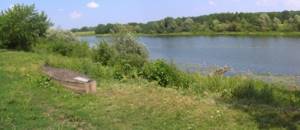
The best place for a good rest and excellent fishing is considered to be the beautiful Seim River. It has about 45 species of fish. Namely:
- Rudd
- Chub
- Pike
- Roach
- crucian carp
- Ide
- Bream
- Zander
- Catfish (sometimes large in size, but most often up to 20 kg).
- Carp.
- Guster.
On the Seim River it is best to fish with a bottom fishing rod, a float rod, or a spinning rod. This river has many shoals and also holes. The depth of such pits can reach up to 9 meters! It is best to catch chub on the rifts, near the bushes. The best way to fish is with fly rods and spinners. The perch bites on the spoon.
According to local and old fishermen, the fish bite best on very old and tarnished spinners. Speaking about spinners, we cannot fail to mention the wonderful Mepps spinners, which very often help out spinners.
The ide bites well on spinning rods. Predators are caught on 15kg jig baits. for spinners and wobblers. An excellent catch can only be achieved from a boat.
The most common places on the Seim River are places near the village of Glushkovo. If you go down the river (God-forsaken places), then there is every chance of catching a real trophy, which every fisherman dreams of.
On the border with Ukraine you can catch rudd, crucian carp, perch, chub, pike, and pike perch. In these places the Seim is deep with many bays.
The Seim River is a wonderful place for fishing and relaxing in picturesque natural surroundings.
Fishing
Many fishermen call the Seim the chub river. Indeed, there are a lot of this underwater inhabitant here. Moreover, there are weighty individuals whose mass exceeds 1.5 kg. This fish is hunted with light spinning rods and fly fishing. The best time to catch it is from May to the end of September.
A popular direction for catching bigheaded fish is considered to be rafting fishing with an ultralight spinning rod. The most catchy baits are miniature cranks. Micro-oscillators, small rotating spoons, and minnows up to 4 cm long also work.
Walking fishing on the Seim River with a spinning rod allows you, in addition to chub, to effectively catch other predatory representatives of the ichthyofauna. Among them are small-medium perch, pike up to 1.5 kg, and small asp. Less often, ide flies in; commercial rudd can take over.
Advice! To catch chub and ide in the summer, local fishermen use a tackle consisting of two combined spinning rods, called a constriction.
Good results when fishing for predators can be achieved using natural bait. The most effective are live bait or a rig with a dead fish. The fisherman also uses black leech, crayfish meat, large worm, and frog.
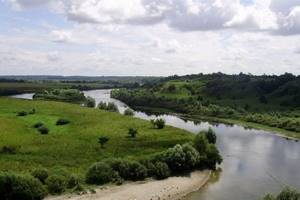
You should look for chub on riffles, bends in the riverbed, and near steep banks
Peaceful fish are caught mainly with float gear. When fishing near the shore, it is enough to take a regular fly rod with a blind rig. Dung worms, caddisfly larvae, maggots, and less often bloodworms, grasshoppers, and small beetles are used as baits.
Among the attachments are:
- dough;
- canned corn;
- filamentous algae;
- crust of bread;
- parboiled wheat.
At long distances they fish with match and Bolognese fishing rods, or you can use an inflatable boat.
Bottom gear is fished mainly at medium and great depths. You can use both modern feeder gear and old-fashioned hooks, weights and elastic bands. From baits and attachments similar to the float directions of the bait.
In winter, people catch fish on the Seimas using vertical spoons and balance beams. You can use jigs near the shore. In quiet areas and in the sleeves, they place girders and stands. From the ice on the river they mainly hunt for perch, roach, silver bream, ruffe and pike.
Lakes
Lake Malino, Makovye
Fishing in these reservoirs is carried out all year round, and only during spawning season you can fish here exclusively with one fishing rod and one hook. The fact is that these reservoirs are located on the territory of a natural reserve. Despite these restrictions, fishing on these lakes is excellent, sometimes even trophy. There are many types of fish here:
- Carp.
- Crucian carp.
- Perch.
- Roach.
- Gorchak.
- Dace.
- Chub.
- Rudd.
- Pike.
Lake Fitizh
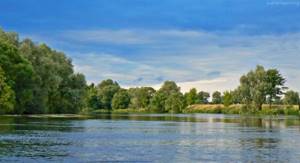
The lake ranks third among local fishermen in terms of territory and fish caught. Fishing here occurs all year round, but fishing is a bit limited during the spawning season. Carp, pike, carp, and catfish are well caught. Small: roach, rudd, perch. Tackle: float and bottom fishing rod, feeder and spinning rod. Seasonal bait: worm, maggot, bread and dough. And also corn and peas. On the lake you can not only have good fishing, but also have a great rest: a fire, songs, fish soup, a tent.....
Kursk Sea (Kurchatov Reservoir), Kursk

Fishermen love this place very much, as this reservoir is home to a large number of different fish. Here you can catch:
- Roach;
- Ruff;
- Pike perch;
- Pike;
- Ide;
- Bream;
- crucian carp;
- Telapia (a new type of exotic fish).
And also: bleak, dace and rudd.
To catch a large pike perch you need to go to the depths, but small specimens are caught in shallow water. It is advisable to fish from a boat. In the summer, crucian carp bites well, sometimes even of considerable size. Tench and perch bite well near the reeds. If you are lucky, you can catch large roach and rudd. Tackle: bottom and float fishing rod, spinning rod. Bait: worm, maggot, dough with cotton wool, corn and peas.
Amazing fact: The Kursk Sea does not freeze in winter, and therefore pleases fishermen with open water fishing all year round.
Good fishing in Znamenka (paid)
Fishing in Znamenka is loved by both professional fishermen and amateurs. In addition to fishing, here you can have a good rest from the bustle of the city and smog. The pond is located near the village of Znamenka, Medvensky district. The reservoir contains a large variety of fish.
- Crucian carp.
- Bream.
- Pike and grass pike.
- Burbot.
- Asp.
- Carp, silver bream, chub.
- Catfish and perch.
- Pike perch and ide.
- Roach and rudd.
Tackle: spinning rod and float rod. Seasonal bait: maggot and worm, dough and semolina, canned corn and peas.
Fishing in Soldatskoye (paid)
To have a good time and come home with a big catch, you should go fishing on a private pond in Soldatskoye. The reservoir is located near the village of Soldatskoye, Gorshechensky district. Getting to the pond will not be difficult, since there is asphalt to the pond itself, and therefore rain and bad weather are not a problem.
The pond is large and wide, there is a dam, the shore is flat and gentle. There are also gazebos for relaxation and parking. You can relax here with the whole family.
You can catch: crucian carp, carp, carp, roach, perch, bleak and grass carp. Bait: Dough, corn, peas and dung worm. Tackle: float rod and spinning rod.
Detailed map of the Kursk region
The region occupies the basins of the Don and Dnieper rivers. They and their tributaries Kshen, Psel, Seim, Svapa, Tuskar, envelop the northern, eastern and central territory with a dense network; in the southwestern part their number is much smaller. The rivers of the region are not full of water, only some of them are navigable. The warm climate has a beneficial effect on the vegetation of the region, the territory of which consists of forests alternating with areas of meadow steppe. The main wealth of the region is its soils - the most fertile black soil, a sample of which is kept in museums around the world as a standard. Therefore, most of the territory is allocated for agricultural crops, the forest area is less than 10%, and forest-steppe has been preserved only in the protected areas of the Central Chernozem Reserve.
Satellite map of the Kursk region online
Most natural lakes are located in the floodplains of large rivers, with very few outside the floodplain. In addition to 870 lakes, there are 785 artificial reservoirs in the region: ponds and reservoirs, the largest of which are Kurskoye, Mikhailovskoye and Starooskolskoye. The geographical location of the region determines a temperate continental climate, with relatively cold winters and warm summers. The winter period begins in the second ten days of November, and the maximum drop in air temperature to -8°C occurs in January. From the last ten days of March it gets warmer, and the beginning of summer, the warmest month of which is July with an air temperature of +20°C, coincides with the end of May.
Detailed map of the Kursk region
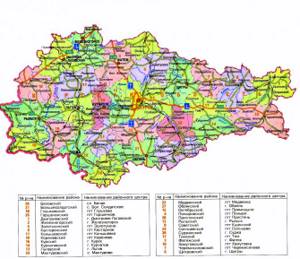
Maps of cities in the Kursk region from satellite:
Satellite map of Kursk Satellite map of Zheleznogorsk Map of Kurchatov from the Lgov satellite. Satellite view
The region's attractions are cultural, historical and environmental in nature. Fans will be able to trace the history of the region, starting from Paleolithic times - the Avdeevskaya site; the burial mounds of the Cheremisinovsky district will tell about the Bronze Age; further history will be told by the statue of the Polovtsian warrior or the Stone Woman located in the steppes of the reserve, fortifications XI-XII, the complex of the participants in the Battle of Kursk. The Annenkov estates of the 18th century testify to the celebrities who lived in these parts. and the Nelidovs of the 19th century, A. Fet and the Baratinsky princes, the chambers of Hetman Mazepa and the house of Peter I. Natural monuments: Linevo Lake, Gladiolus Meadow, Zobolotovsky Forest, painted with oxides in different colors Colored lakes, the largest lake Lezvino - created for preservation and study rare specimens of flora and fauna of the Kursk region. Pilgrims will definitely visit the shrines of the region: wooden churches, one of which is the Church of the Holy Trinity, the famous Root Monastery, Alexander Nevsky Cathedral and many others. The administrative center of the region is the city of Kursk, the symbol of which is a monument to an apple, weighing more than 100 kg. Known for its iron ore mining - Zheleznogorsk. The largest nuclear power plant in Russia, Kursk Nuclear Power Plant, is located in Kurchatov. Other large cities in the region are Lgov, Oboyan, Rylsk and Shchigry.
Fishing competitions in the Kursk region
Every winter, jig fishing competitions are held in the Kursk region. Anyone can take part. You just need to submit an application. Competitions are characterized by great excitement, a desire to win and catch a trophy. Summer fishing also attracts great interest from professional fishermen.
Fishing competitions always take place in places where there are plenty of fish. You just need to know all the intricacies of fishing: what fish bites what and when.
Video report on the second fishing cup:
Where, when and what to catch pike with
An increase in the toothed population has recently been observed in the Seim and Tuskar rivers. Promising places: driftwood and snags, rifts and holes, quiet coves and bays.
Best time and bait for fishing
Spring
The first peak of activity occurs in mid-March, after the water warms up to 5–6 °C. It lasts 2–3 weeks, until spawning.
The second wave of spring zhora occurs a week after spawning. Pike feeds with double appetite. The wild bite lasts for a couple of weeks - that’s about the time it takes for the fish to fully restore the energy it has expended.
Among the spinning baits in use are rubber, spinners, spinnerbaits with a large petal, and oscillating spoons . The range of the bait in the spring does not matter - the predator is taken at this time close to the shore.
In addition to spinning, for pike fishing in the spring in the Kursk region, they use girders and mugs for live bait.
Summer
In summer, pike becomes more cautious. The chances of good fishing increase in cloudy weather, with a slight decrease in atmospheric pressure. A light breeze and rain (but not heavy rain) also make for successful fishing.
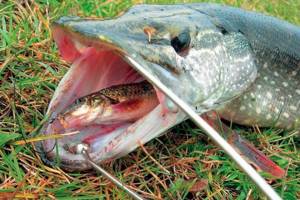
Fishing with live bait
Autumn
The golden time for toothy hunters begins at the end of September – beginning of October. During this period, the fish recovers from the heat and begins to vigorously scour the upper water column.
Fishing with wobblers
The best results are shown by spinning fishing using spinners and wobblers. Autumn zhor is observed closer to November. The predator indiscriminately swallows wobblers, jig baits, oscillating and rotating spoons. In addition to spinning, live bait gear works great at this time.
Where to fish
Popular places for pike fishing in the Kursk region: backwaters of Seim, Svapa below the mouth of Nistunka, Psel near Kurilovka, Kurchatovskoye Reservoir, pond in Mashkino.
Fishing on the Kurchatov Reservoir
Fishing shops in Kursk
In anticipation of a big catch, you need to carefully prepare for fishing. According to professional fishermen, gear and bait play a big role. The most popular fishing stores:
- Trophy (Sumskaya str. 25)
- Fishing store (Red Army St. 82)
- Fishing goods (Verkhnyaya Lugovaya str. 22)
- Podsekai (21 Kosukhina St.)
- Hunting lodge (street 50 let Oktyabrya 3)
See the large fishing forum Fion - a section with fishing in the Kursk region.
Have a good fishing and a huge catch!
